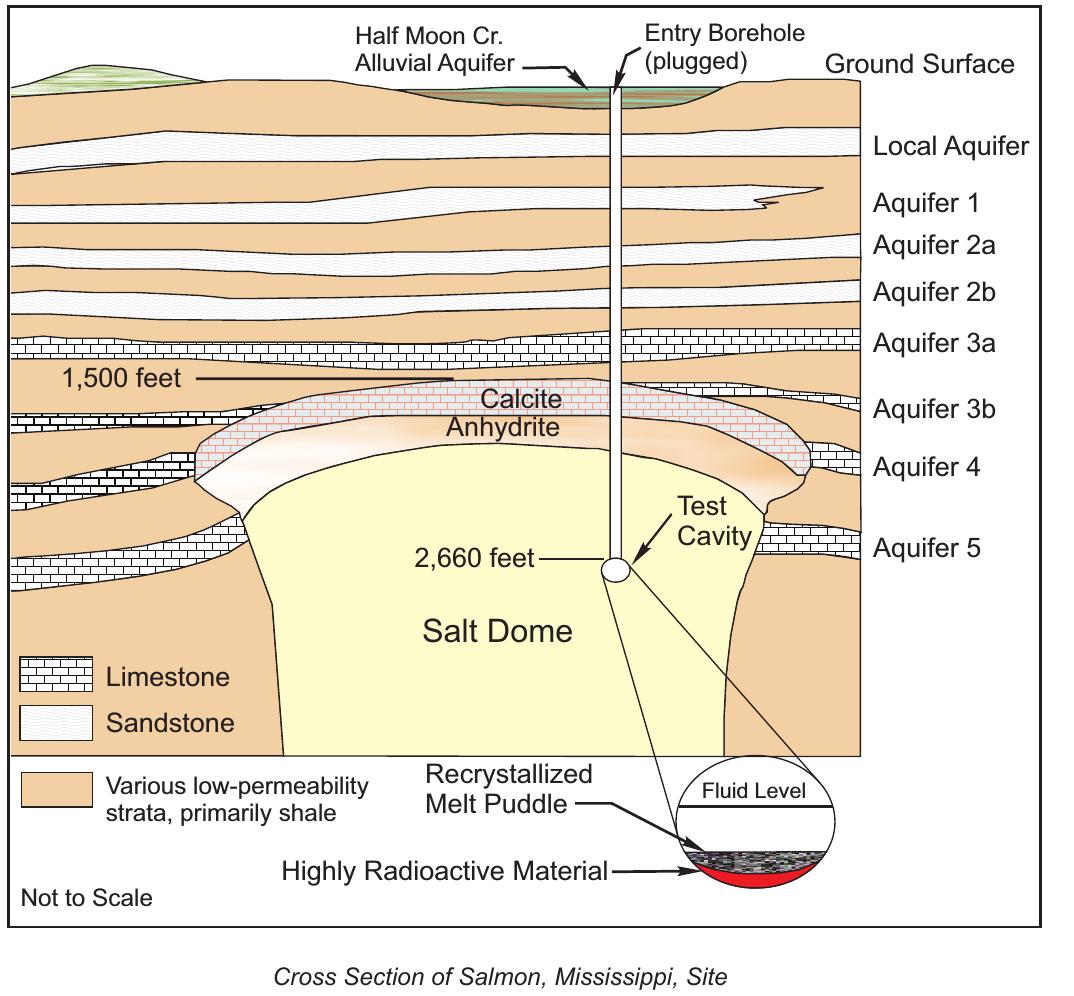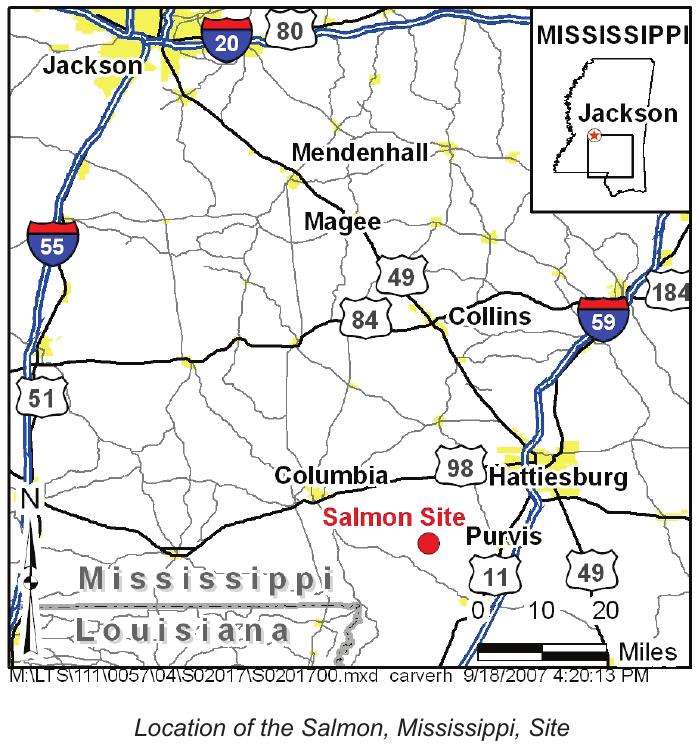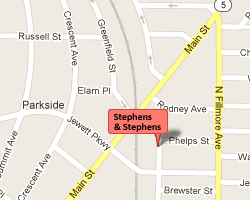Salmon Nuclear Explosion Site
Home / Areas of Practice / Energy Employees Occupational Illness Compensation Program Act (EEOICPA) / EEOICP: Facility List / Salmon Nuclear Explosion Site
Also Known As: Tatum Dome Test Site
State: Mississippi
Location: Hattiesburg
Time Period: 1964-1972
Facility Type: Department of Energy
Facility Description
The Salmon Test Site was the location for two nuclear and two methane-oxygen gas explosion tests conducted deep underground in the Tatum Salt Dome. The tests were part of a program designed to detect, identify, and locate underground nuclear explosions.
Drilling for the “Salmon” event began in April 1963. The Salmon test shot was fired on October 22, 1964. Post-shot activities were completed by June 30, 1965.
After the Salmon post-shot activities were completed, the Sterling shot was detonated in the Salmon cavity on December 3, 1966. In March 1968, Sterling cavity reentry drilling, surveying, and coring was begun. The facilities were shut down and the site was placed on standby status on April 12, 1968.
In November 1968, the cavity was prepared for the non-nuclear experiment called “Diode Tube.” The shot was fired on February 1, 1969; post-shot activities were completed and the operation ended in June 1969.
Another non-nuclear event, called “Humid Water” took place in 1970. The cavity was prepared in February 1970 and the shot was fired on April 19, 1970. The site was decommissioned on June 29, 1972.
Listing
Salmon Nuclear Explosion Site is listed as a Department of Energy (DOE) site under the EEOICPA.
Compensation
As of 05/17/2015, the total compensation paid under Parts B and E of the EEOICPA, including medical compensation, for workers suffering from the effects of having worked at the Salmon Nuclear Explosion Site is $5,407,989.
Salmon Nuclear Explosion Site Workers
If you or your parent worked at this or any other DOE or AWE facility and became ill, you may be entitled to compensation of up to $400K plus medical benefits from the US Department of Labor. Call EEOICPA Counsel Hugh Stephens at 1-855-EEOICPA (336-4272) or fill out the form to the right, even if your claim has been accepted or denied.
We can help with all OWCP (Federal Workers Compensation) claims, impairments, wage loss and health care. 2495 Main Street, Suite 442, Buffalo, NY 14214.
Site Description and History
The Salmon, Mississippi, Site, also called the Tatum Dome Test Site, is a 1,470-acre tract of land in Lamar County, Mississippi, 21 miles southwest of Hattiesburg. The nearest town is Purvis, about 10 miles east of the site.
The site is in a forested region known as the long-leaf pine belt of the Gulf Coastal Plain. Elevations in the area range from about 240 to 350 feet above sea level. The site overlies a salt formation called the Tatum Salt Dome. Land around the Salmon site has residential, industrial, and commercial use, although no one lives within the boundary of the site itself.
The U.S. Atomic Energy Commission (AEC), a predecessor agency of the U.S. Department of Energy (DOE), and the U.S. Department of Defense conducted two underground nuclear tests at the site under the designation of Project Dribble, part of a larger program known as the Vela Uniform program. Two gas explosive tests, designated Project Miracle Play, were also conducted at the site.
The Vela Uniform program was part of a Department of Defense research and development program intended to improve the capability of detecting, monitoring, and identifying underground nuclear detonations. As part of the Vela Uniform program, nuclear tests were conducted near Fallon, Nevada (Project Shoal), on Amchitka Island, Alaska (Project Long Shot), and near Hattiesburg, Mississippi (Projects Salmon and Sterling).
Projects Salmon and Sterling were designed to evaluate seismic signals from detonations in a salt medium (the Tatum Salt Dome). The Salmon and Sterling tests were the second and fourth nuclear tests in the program. The Salmon test took place on October 22, 1964, at a depth of 2,700 feet below ground surface, which is approximately 1,200 feet below the top of the salt dome. This 5.3-kiloton-yield test created an underground test cavity approximately 110 feet in diameter at the depth of the detonation. The second, smaller test, Sterling, conducted on December 3, 1966, consisted of a 380-ton-yield nuclear device suspended in the cavity created by the Salmon test.
Two methane-oxygen explosions were conducted in the Salmon cavity–one (called the Diode Tube) on February 2, 1969, and the other (called the Humid Water) on April 19, 1970. Each test had a yield of approximately 315 tons.

The salt dome fully contained all of the tests, and no radionuclides were released to the surface. Radioactive fission products and other materials generated during the tests are contained in the test cavity and in the salt near the cavity. Following each of the tests, reentry holes were drilled into the test cavity to collect scientific data and to emplace devices. These drilling operations generated waste, which included contaminated drill cuttings and drilling fluids. In addition, support operations generated other contaminated materials. Test site support activities required fuel, electricity, sanitation, waste storage, waste disposal, and the use of hazardous materials.
Site Conditions
The site cleanup and decommissioning activities began in 1971. Contaminated buildings and equipment were shipped to the Nevada National Security Site (formerly Nevada Test Site) for disposal; contaminated soils, slurried with fresh water, and other liquid materials were disposed of in the underground test cavity. Liquid wastes from the Salmon reentry operations were injected into a deep brine aquifer (known as Aquifer 5) for disposal. Liquid wastes from the Sterling reentry operations were solidified and shipped to Oak Ridge, Tennessee, for burial. Miscellaneous sanitary wastes were buried onsite in shallow pits excavated for soils to replace contaminated soils. These pits were subsequently covered with clean soil and graded. A high water table elevation prevented complete excavation and removal of contamination at ground zero, and the shallow mud pit less than 100 meters away. The mud pit excavation was backfilled with clean soil and reseeded.
Cleanup and decommissioning activities officially ended June 30, 1972, the same day the AEC site lease with the original landowner expired. A new 10-year lease agreement gave DOE exclusive rights to regulate and control subsurface penetration and allowed continued site access to conduct monitoring activities. The lease was later renewed for a second 10-year period. During the 1972 to 1992 lease period, the site was used as a private timber plantation.
Radioactivity remains in the test cavity that is deep within the salt structure. The salt is nearly impermeable and has little or no capacity to transmit water. Therefore, the salt structure provides sufficient geologic isolation to prevent the radioactivity from migrating.
Shortly after the creation of DOE’s Environmental Management program in 1989, concerned citizens, the State of Mississippi, and congressional leaders raised questions about the site. When DOE acquired the site in 1992, the agency initiated a series of studies to verify site conditions and investigate whether residual contamination remained that had not been detected in previous investigations. The studies were completed and issued in the Salmon Site Remedial Investigation Report (DOE/NV-494-Vol.1/Rev. 1, 1999).
Results confirmed that decommissioning of the surface resulted in conditions protective of human health and the environment, that neither the test cavity nor the deep aquifer was leaking, and that wastes disposed of there were adequately contained. The human health risk assessment indicated that the only unacceptable risks would be through using the site in a residential scenario. Recreational visitors and workers in the area (e.g., park rangers) would not be subject to unacceptable risks. At least 95 percent of the risk is due to naturally occurring radioactive material. The residential scenario risk was higher due to the added pathway of ingestion of produce grown in site soil, particularly produce grown within 100 meters of ground zero.
In 2010, DOE transferred surface ownership of the Salmon site to the State of Mississippi so that the site could be used as a wildlife refuge and working demonstration forest. DOE retains the rights to the subsurface of the Salmon site property and will continue the monitoring of surface water and groundwater to ensure protection of public health and the environment.
Institutional Controls
Institutional controls are in place to ensure protection of the public and the environment. DOE has placed a deed restriction on the land parcel, which prohibits excavation, drilling, or removal of material without prior approval from DOE. Angle drilling from outside the property boundary to within the property boundary is also prohibited.
Long-Term Hydrologic Monitoring Program
Since 1972, surface water and groundwater have been monitored annually at the Salmon site as part of a long- term hydrologic monitoring program. In 2014, the sampling interval was changed to every 18 months, to capture possible seasonal variations. Water samples are collected for analysis of signature radionuclides from the nuclear detonations. Monitoring wells near areas of buried drilling fluids are also sampled for organic compounds and metals that may remain entrained in pockets of the buried material. The State of Mississippi participates in the DOE sampling program and is onsite during sampling events.

Share this:
EEOICPA CLAIMS
If you or your parent worked any of the DOE or AWE facilities listed on this website and became ill, you may be entitled to compensation of up to $400K plus medical benefits from the US Department of Labor.
Call EEOICPA Counsel Hugh Stephens at 1-800-548-4494, email hstephens@stephensstephens.com, or fill out the form below whether or not you have already filed a claim and even if your claim has been accepted or denied.
Contact Us
"*" indicates required fields
*note: Submission of this form does not establish an attorney-client privilege.
Contact Us
Address:
2495 Main Street, Suite 442
Buffalo, New York 14214
Phone:
(716) 852-7590
Fax:
(716) 852-7599
After Hours:
(716) 208-3525
Email Us:
R. William Stephens, Esq.
R. Hugh Stephens, Esq.
Lisa P. Neff, Esq.

